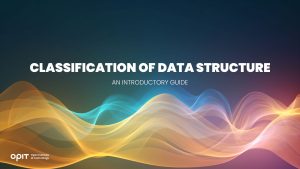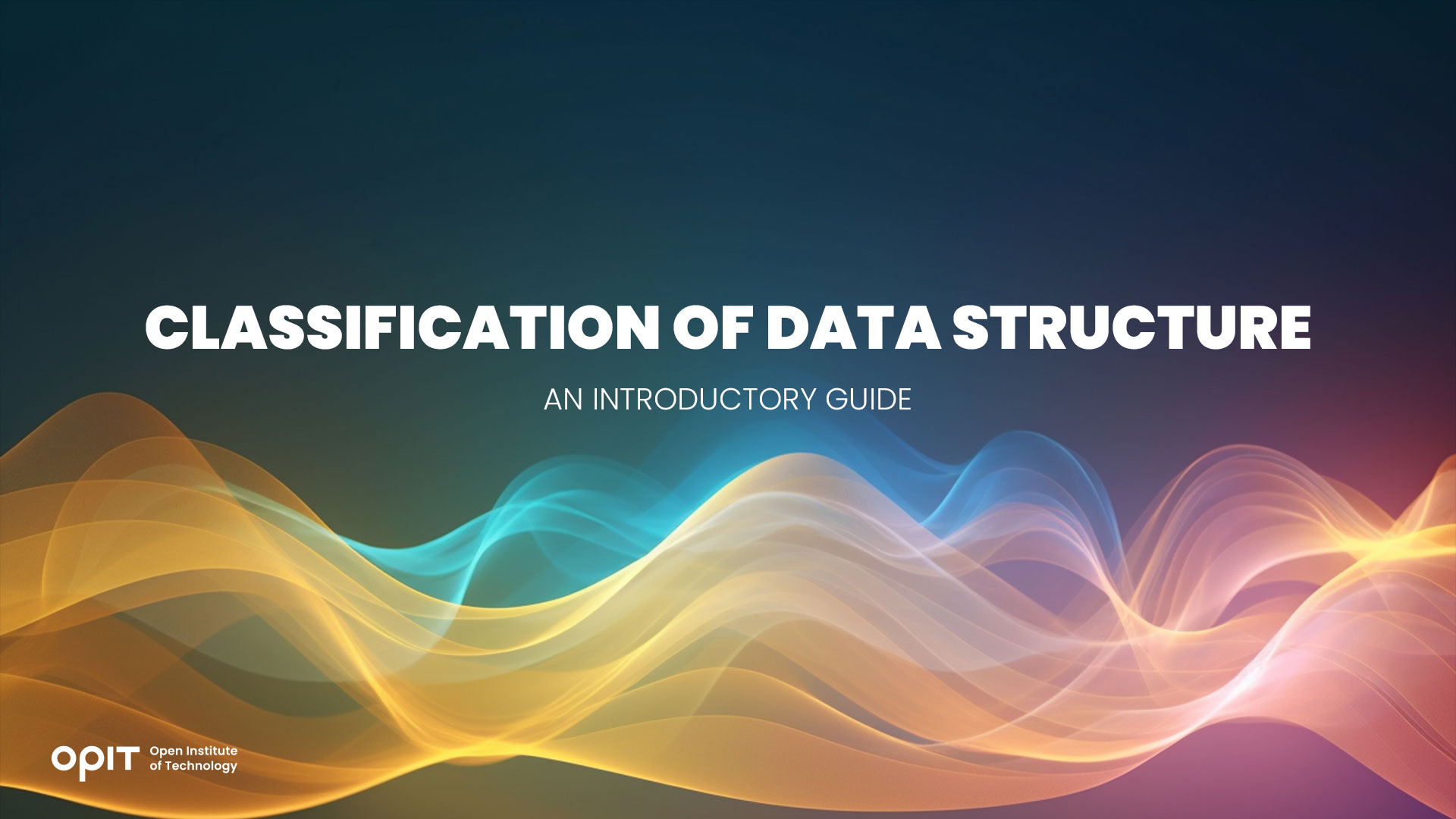

Most people feel much better when they organize their personal spaces. Whether that’s an office, living room, or bedroom, it feels good to have everything arranged. Besides giving you a sense of peace and satisfaction, a neatly-organized space ensures you can find everything you need with ease.
The same goes for programs. They need data structures, i.e., ways of organizing data to ensure optimized processing, storage, and retrieval. Without data structures, it would be impossible to create efficient, functional programs, meaning the entire computer science field wouldn’t have its foundation.
Not all data structures are created equal. You have primitive and non-primitive structures, with the latter being divided into several subgroups. If you want to be a better programmer and write reliable and efficient codes, you need to understand the key differences between these structures.
In this introduction to data structures, we’ll cover their classifications, characteristics, and applications.
Primitive Data Structures
Let’s start our journey with the simplest data structures. Primitive data structures (simple data types) consist of characters that can’t be divided. They aren’t a collection of data and can store only one type of data, hence their name. Since primitive data structures can be operated (manipulated) directly according to machine instructions, they’re invaluable for the transmission of information between the programmer and the compiler.
There are four basic types of primitive data structures:
- Integers
- Floats
- Characters
- Booleans
Integers
Integers store positive and negative whole numbers (along with the number zero). As the name implies, integer data types use integers (no fractions or decimal points) to store precise information. If a value doesn’t belong to the numerical range integer data types support, the server won’t be able to store it.
The main advantages here are space-saving and simplicity. With these data types, you can perform arithmetic operations and store quantities and counts.
Floats
Floats are the opposite of integers. In this case, you have a “floating” number or a number that isn’t whole. They offer more precision but still have a high speed. Systems that have very small or extremely large numbers use floats.
Characters
Next, you have characters. As you may assume, character data types store characters. The characters can be a string of uppercase and/or lowercase single or multibyte letters, numbers, or other symbols that the code set “approves.”
Booleans
Booleans are the third type of data supported by computer programs (the other two are numbers and letters). In this case, the values are positive/negative or true/false. With this data type, you have a binary, either/or division, so you can use it to represent values as valid or invalid.
Linear Data Structures
Let’s move on to non-primitive data structures. The first on our agenda are linear data structures, i.e., those that feature data elements arranged sequentially. Every single element in these structures is connected to the previous and the following element, thus creating a unique linear arrangement.
Linear data structures have no hierarchy; they consist of a single level, meaning the elements can be retrieved in one run.
We can distinguish several types of linear data structures:
- Arrays
- Linked lists
- Stacks
- Queues
Arrays
Arrays are collections of data elements belonging to the same type. The elements are stored at adjoining locations, and each one can be accessed directly, thanks to the unique index number.
Arrays are the most basic data structures. If you want to conquer the data science field, you should learn the ins and outs of these structures.
They have many applications, from solving matrix problems to CPU scheduling, speech processing, online ticket booking systems, etc.
Linked Lists
Linked lists store elements in a list-like structure. However, the nodes aren’t stored at contiguous locations. Here, every node is connected (linked) to the subsequent node on the list with a link (reference).
One of the best real-life applications of linked lists is multiplayer games, where the lists are used to keep track of each player’s turn. You also use linked lists when viewing images and pressing right or left arrows to go to the next/previous image.
Stacks
The basic principles behind stacks are LIFO (last in, first out) or FILO (first in, last out). These data structures stick to a specific order of operations and entering and retrieving information can be done only from one end. Stacks can be implemented through linked lists or arrays and are parts of many algorithms.
With stacks, you can evaluate and convert arithmetic expressions, check parentheses, process function calls, undo/redo your actions in a word processor, and much more.
Queues
In these linear structures, the principle is FIFO (first in, first out). The data the program stores first will be the first to process. You could say queues work on a first-come, first-served basis. Unlike stacks, queues aren’t limited to entering and retrieving information from only one end. Queues can be implemented through arrays, linked lists, or stacks.
There are three types of queues:
- Simple
- Circular
- Priority
You use these data structures for job scheduling, CPU scheduling, multiple file downloading, and transferring data.
Non-Linear Data Structures
Non-linear and linear data structures are two diametrically opposite concepts. With non-linear structures, you don’t have elements arranged sequentially. This means there isn’t a single sequence that connects all elements. In this case, you have elements that can have multiple paths to each other. As you can imagine, implementing non-linear data structures is no walk in the park. But it’s worth it. These structures allow multi-level storage (hierarchy) and offer incredible memory efficiency.
Here are three types of non-linear data structures we’ll cover:
- Trees
- Graphs
- Hash tables
Trees
Naturally, trees have a tree-like structure. You start at the root node, which is divided into other nodes, and end up with leaf modes. Every node has one “parent” but can have multiple “children,” depending on the structure. All nodes contain some type of data.
Tree structures provide easier access to specific data and guarantee efficiency.
Three structures are often used in game development and indexing databases. You’ll also use them in machine learning, particularly decision analysis.
Graphs
The two most important elements of every graph are vertices (nodes) and edges. A graph is essentially a finite collection of vertices connected by edges. Although they may look simple, graphs can handle the most complex tasks. They’re used in operating systems and the World Wide Web.
You unconsciously use graphs with Google Maps. When you want to know the directions to a specific location, you enter it in the map. At that point, the location becomes the node, and the path that guides you is the edge.
Hash Tables
With hash tables, you store information in an associative manner. Every data value gets its unique index value, meaning you can quickly find exactly what you’re looking for.
This may sound complex, so let’s check out a real-life example. Think of a library with over 30,000 books. Every book gets a number, and the librarian uses this number when trying to locate it or learn more details about it.
That’s exactly how hash tables work. They make the search process and insertion much faster, which is why they have a wide array of applications.
Specialized Data Structures
When data structures can’t be classified as either linear or non-linear, they’re called specialized data structures. These structures have unique applications and principles and are used to represent specialized objects.
Here are three examples of these structures:
- Trie
- Bloom Filter
- Spatial Data
Trie
No, this isn’t a typo. “Trie” is derived from “retrieval,” so you can guess its purpose. A trie stores data which you can represent as graphs. It consists of nodes and edges, and every node contains a character that comes after the word formed by the parent node. This means that a key’s value is carried across the entire trie.
Bloom Filter
A bloom filter is a probabilistic data structure. You use it to analyze a set and investigate the presence of a specific element. In this case, “probabilistic” means that the filter can determine the absence but can result in false positives.
Spatial Data Structures
These structures organize data objects by position. As such, they have a key role in geographic systems, robotics, and computer graphics.
Choosing the Right Data Structure
Data structures can have many benefits, but only if you choose the right type for your needs. Here’s what to consider when selecting a data structure:
- Data size and complexity – Some data structures can’t handle large and/or complex data.
- Access patterns and frequency – Different structures have different ways of accessing data.
- Required data structure operations and their efficiency – Do you want to search, insert, sort, or delete data?
- Memory usage and constraints – Data structures have varying memory usages. Plus, every structure has limitations you’ll need to get acquainted with before selecting it.
Jump on the Data Structure Train
Data structures allow you to organize information and help you store and manage it. The mechanisms behind data structures make handling vast amounts of data much easier. Whether you want to visualize a real-world challenge or use structures in game development, image viewing, or computer sciences, they can be useful in various spheres.
As the data industry is evolving rapidly, if you want to stay in the loop with the latest trends, you need to be persistent and invest in your knowledge continuously.
Related posts

Source:
- Agenda Digitale, published on November 25th, 2025
In recent years, the word ” sustainability ” has become a firm fixture in the corporate lexicon. However, simply “doing no harm” is no longer enough: the climate crisis , social inequalities , and the erosion of natural resources require a change of pace. This is where the net-positive paradigm comes in , a model that isn’t content to simply reduce negative impacts, but aims to generate more social and environmental value than is consumed.
This isn’t about philanthropy, nor is it about reputational makeovers: net-positive is a strategic approach that intertwines economics, technology, and corporate culture. Within this framework, digitalization becomes an essential lever, capable of enabling regenerative models through circular platforms and exponential technologies.
Blockchain, AI, and IoT: The Technological Triad of Regeneration
Blockchain, Artificial Intelligence, and the Internet of Things represent the technological triad that makes this paradigm shift possible. Each addresses a critical point in regeneration.
Blockchain guarantees the traceability of material flows and product life cycles, allowing a regenerated dress or a bottle collected at sea to tell their story in a transparent and verifiable way.
Artificial Intelligence optimizes recovery and redistribution chains, predicting supply and demand, reducing waste and improving the efficiency of circular processes .
Finally, IoT enables real-time monitoring, from sensors installed at recycling plants to sharing mobility platforms, returning granular data for quick, informed decisions.
These integrated technologies allow us to move beyond linear vision and enable systems in which value is continuously regenerated.
New business models: from product-as-a-service to incentive tokens
Digital regeneration is n’t limited to the technological dimension; it’s redefining business models. More and more companies are adopting product-as-a-service approaches , transforming goods into services: from technical clothing rentals to pay-per-use for industrial machinery. This approach reduces resource consumption and encourages modular design, designed for reuse.
At the same time, circular marketplaces create ecosystems where materials, components, and products find new life. No longer waste, but input for other production processes. The logic of scarcity is overturned in an economy of regenerated abundance.
To complete the picture, incentive tokens — digital tools that reward virtuous behavior, from collecting plastic from the sea to reusing used clothing — activate global communities and catalyze private capital for regeneration.
Measuring Impact: Integrated Metrics for Net-Positiveness
One of the main obstacles to the widespread adoption of net-positive models is the difficulty of measuring their impact. Traditional profit-focused accounting systems are not enough. They need to be combined with integrated metrics that combine ESG and ROI, such as impact-weighted accounting or innovative indicators like lifetime carbon savings.
In this way, companies can validate the scalability of their models and attract investors who are increasingly attentive to financial returns that go hand in hand with social and environmental returns.
Case studies: RePlanet Energy, RIFO, and Ogyre
Concrete examples demonstrate how the combination of circular platforms and exponential technologies can generate real value. RePlanet Energy has defined its Massive Transformative Purpose as “Enabling Regeneration” and is now providing sustainable energy to Nigerian schools and hospitals, thanks in part to transparent blockchain-based supply chains and the active contribution of employees. RIFO, a Tuscan circular fashion brand, regenerates textile waste into new clothing, supporting local artisans and promoting workplace inclusion, with transparency in the production process as a distinctive feature and driver of loyalty. Ogyre incentivizes fishermen to collect plastic during their fishing trips; the recovered material is digitally tracked and transformed into new products, while the global community participates through tokens and environmental compensation programs.
These cases demonstrate how regeneration and profitability are not contradictory, but can actually feed off each other, strengthening the competitiveness of businesses.
From Net Zero to Net Positive: The Role of Massive Transformative Purpose
The crucial point lies in the distinction between sustainability and regeneration. The former aims for net zero, that is, reducing the impact until it is completely neutralized. The latter goes further, aiming for a net positive, capable of giving back more than it consumes.
This shift in perspective requires a strong Massive Transformative Purpose: an inspiring and shared goal that guides strategic choices, preventing technology from becoming a sterile end. Without this level of intentionality, even the most advanced tools risk turning into gadgets with no impact.
Regenerating business also means regenerating skills to train a new generation of professionals capable not only of using technologies but also of directing them towards regenerative business models. From this perspective, training becomes the first step in a transformation that is simultaneously cultural, economic, and social.
The Regenerative Future: Technology, Skills, and Shared Value
Digital regeneration is not an abstract concept, but a concrete practice already being tested by companies in Europe and around the world. It’s an opportunity for businesses to redefine their role, moving from mere economic operators to drivers of net-positive value for society and the environment.
The combination of blockchain, AI, and IoT with circular product-as-a-service models, marketplaces, and incentive tokens can enable scalable and sustainable regenerative ecosystems. The future of business isn’t just measured in terms of margins, but in the ability to leave the world better than we found it.

Source:
- Raconteur, published on November 06th, 2025
Many firms have conducted successful Artificial Intelligence (AI) pilot projects, but scaling them across departments and workflows remains a challenge. Inference costs, data silos, talent gaps and poor alignment with business strategy are just some of the issues that leave organisations trapped in pilot purgatory. This inability to scale successful experiments means AI’s potential for improving enterprise efficiency, decision-making and innovation isn’t fully realised. So what’s the solution?
Although it’s not a magic bullet, an AI operating model is really the foundation for scaling pilot projects up to enterprise-wide deployments. Essentially it’s a structured framework that defines how the organisation develops, deploys and governs AI. By bringing together infrastructure, data, people, and governance in a flexible and secure way, it ensures that AI delivers value at scale while remaining ethical and compliant.
“A successful AI proof-of-concept is like building a single race car that can go fast,” says Professor Yu Xiong, chair of business analytics at the UK-based Surrey Business School. “An efficient AI technology operations model, however, is the entire system – the processes, tools, and team structures – for continuously manufacturing, maintaining, and safely operating an entire fleet of cars.”
But while the importance of this framework is clear, how should enterprises establish and embed it?
“It begins with a clear strategy that defines objectives, desired outcomes, and measurable success criteria, such as model performance, bias detection, and regulatory compliance metrics,” says Professor Azadeh Haratiannezhadi, co-founder of generative AI company Taktify and professor of generative AI in cybersecurity at OPIT – the Open Institute of Technology.
Platforms, tools and MLOps pipelines that enable models to be deployed, monitored and scaled in a safe and efficient way are also essential in practical terms.
“Tools and infrastructure must also be selected with transparency, cost, and governance in mind,” says Efrain Ruh, continental chief technology officer for Europe at Digitate. “Crucially, organisations need to continuously monitor the evolving AI landscape and adapt their models to new capabilities and market offerings.”
An open approach
The most effective AI operating models are also founded on openness, interoperability and modularity. Open source platforms and tools provide greater control over data, deployment environments and costs, for example. These characteristics can help enterprises to avoid vendor lock-in, successfully align AI to business culture and values, and embed it safely into cross-department workflows.
“Modularity and platformisation…avoids building isolated ‘silos’ for each project,” explains professor Xiong. “Instead, it provides a shared, reusable ‘AI platform’ that integrates toolchains for data preparation, model training, deployment, monitoring, and retraining. This drastically improves efficiency and reduces the cost of redundant work.”
A strong data strategy is equally vital for ensuring high-quality performance and reducing bias. Ideally, the AI operating model should be cloud and LLM agnostic too.
“This allows organisations to coordinate and orchestrate AI agents from various sources, whether that’s internal or 3rd party,” says Babak Hodjat, global chief technology officer of AI at Cognizant. “The interoperability also means businesses can adopt an agile iterative process for AI projects that is guided by measuring efficiency, productivity, and quality gains, while guaranteeing trust and safety are built into all elements of design and implementation.”
A robust AI operating model should feature clear objectives for compliance, security and data privacy, as well as accountability structures. Richard Corbridge, chief information officer of Segro, advises organisations to: “Start small with well-scoped pilots that solve real pain points, then bake in repeatable patterns, data contracts, test harnesses, explainability checks and rollback plans, so learning can be scaled without multiplying risk. If you don’t codify how models are approved, deployed, monitored and retired, you won’t get past pilot purgatory.”
Of course, technology alone can’t drive successful AI adoption at scale: the right skills and culture are also essential for embedding AI across the enterprise.
“Multidisciplinary teams that combine technical expertise in AI, security, and governance with deep business knowledge create a foundation for sustainable adoption,” says Professor Haratiannezhadi. “Ongoing training ensures staff acquire advanced AI skills while understanding associated risks and responsibilities.”
Ultimately, an AI operating model is the playbook that enables an enterprise to use AI responsibly and effectively at scale. By drawing together governance, technological infrastructure, cultural change and open collaboration, it supports the shift from isolated experiments to the kind of sustainable AI capability that can drive competitive advantage.
In other words, it’s the foundation for turning ambition into reality, and finally escaping pilot purgatory for good.
Have questions?
Visit our FAQ page or get in touch with us!
Write us at +39 335 576 0263
Get in touch at hello@opit.com
Talk to one of our Study Advisors
We are international
We can speak in:


